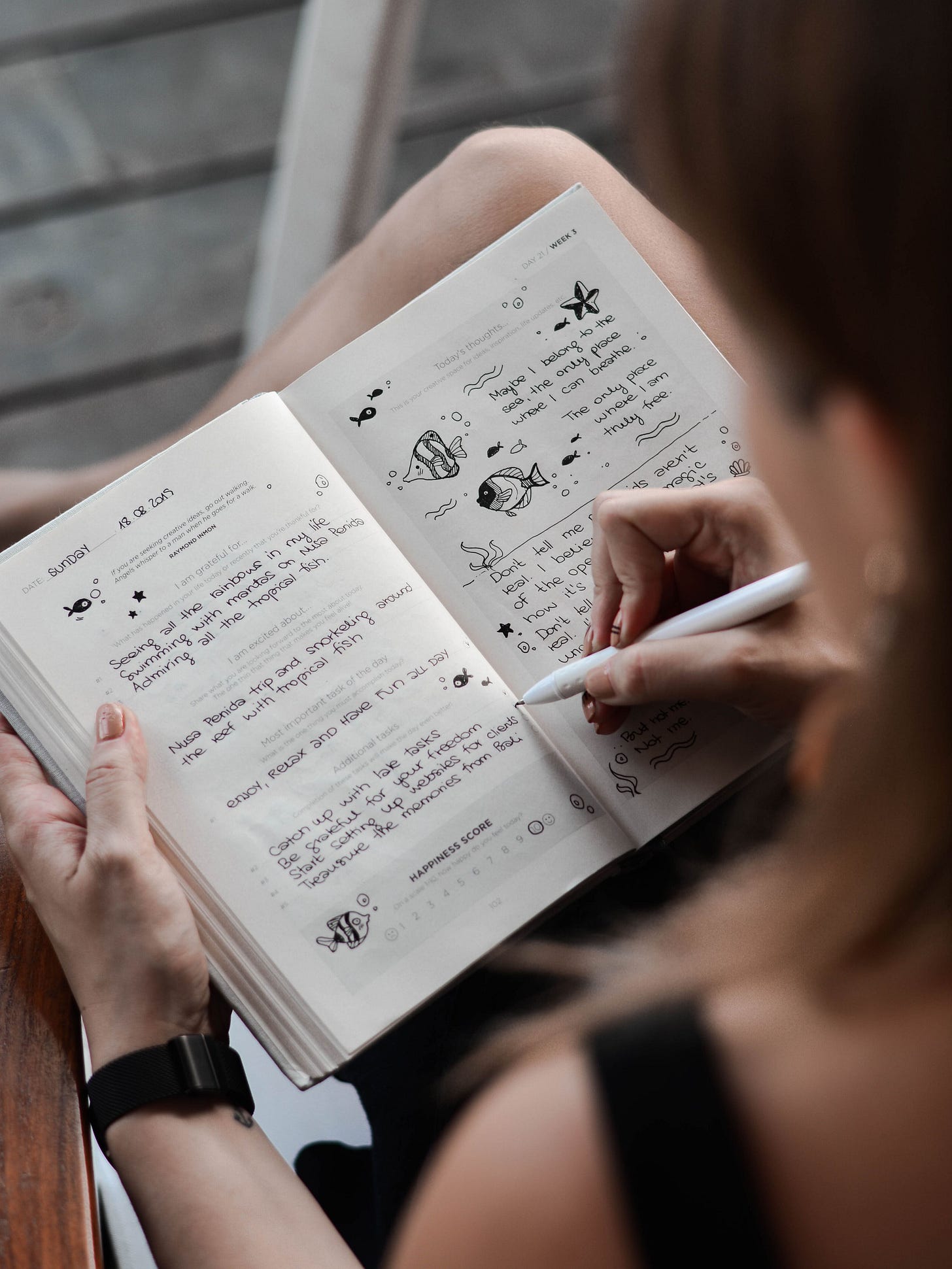College Study Tip #3: Take Great Notes
Whether studying for an exam or preparing to write a paper, there are methods for taking good notes.
This post is part of a 10-week series on study tips for college students. (Some of these tips apply equally well to high school students!) Look for one top tip delivered to your inbox weekly on Thursdays in March through May.
Photo by Unseen Studio on Unsplash
*** I took a longer break than originally planned. The week after my spring break, it was my son’s. And we took Thursday off to play together. Then I came down with a horrible double-whammy of bronchitis coupled with laryngitis. But I’m all better now! So back to our regular schedule, picking up with study tip #3. Plus, there are plenty more tips to come throughout April and May to help you prepare for the end-of-semester crunch! ***
As a writer, I always have a notebook and pen handy. They live in all my bags and are filled with endless random musings. The trouble is, I often end up with notebooks brimming with my thoughts, ideas, and awesome lines, only to lose those ideas anyway because I haven’t mastered a good system for organizing those notes.
Needless to say, taking good notes is about more than writing down what your professor says in class (or the random thoughts that appear unbidden in your head). It means taking notes in a way that makes it easy for you to review key concepts and find what you need to study for exams or to write papers.
Find a Note-Taking Method that Works For You
Photo by Glenn Carstens-Peters on Unsplash
Taking useful notes starts with picking a method that works for you — meaning your creative brain and your learning style.
And, yes, there absolutely are a variety of methods for note-taking. Taking good notes isn’t simply jotting down whatever your professor tells you. It’s about organizing thoughts to make them useful when studying for those exams or finding the quotes and facts you need to assemble a research paper.
Here are the five most common note-taking methods. Visit Best Colleges for more on the pros & cons of each and Become Your Most for visual examples.
Cornell Notes
Taking notes in Cornell fashion involves making two columns on your note page. On the left-hand side, you write key concepts or phrases and sometimes questions about the material. Then, you write more detailed notes about each concept or question in the right-hand column.
Cornell notes provide an easy way to review ideas and study for exams because you can fold your paper in half and look only at the key concepts while you test yourself on the details.
Outlining
The outlining method is exactly as it sounds: You organize class concepts into a formal outline, starting with key concepts and working downward in layers of detail.
Outlines make it easy to study for exams because your notes will be organized around core concepts. Plus, outlines are paper-writing 101. Once you’ve arranged your thoughts topically, all you need to do to write a paper is turn those thoughts into sentences.
But it can be challenging to construct an outline while listening to a class lecture. So outlines work best for taking notes on textbooks and organizing papers. However, you can always take your class notes and organize them into an outline post-lecture.
Also, know that your outline doesn’t have to be overly formal — with Roman numerals and letters — especially if it’s just for you and your professor will never see it. Instead, you can write key concepts in big letters and bullet-point the details underneath each concept as a handy way to organize your notes.
Mapping
Visual learners may find mapping most useful. In this note-taking method, you draw the core concept in the center of the page and then branch out with subtopics and sub-subtopics. (Yes, I often make up words. But I’m an English professor and a writer, so I figure I get to!)
Mapping is actually a method for outlining. Most outlines do the same thing: They start with the big picture and then add in levels of detail. But it might be easier for some learners to remember concepts when they’re drawn in the visual style of a “map” rather than the list style of an outline, especially when you add visual effects like colors or images.
Charting
Like Cornell notes, charting involves dividing your paper into columns. But rather than write key concepts vertically, you write them across the top of your paper.
This method works best when lecture material is predictable, for example, when your professor reviews a chapter or reading from your textbook.
Determine before class what key concepts will likely be covered, then divide your paper into that number of columns. Next, write the key concepts at the top of each column. Then, during the lecture, you can fill in your columns with the important details.
Sentences
Rather than bullet-point concepts and details in short phrases, this method involves writing important information in sentence form.
Why bother? Writing key bits of information fleshed out in your own words helps solidify that information so you remember it come exam time.
Take Notes By Hand
Photo by Kajetan Sumila on Unsplash
Regardless of which note-taking method you adopt, always take notes by hand. Research shows it helps you retain information better because it’s slower and requires more thought.
If you prefer digital notes, then use a writing tablet or writing laptop to handwrite them on your computer. Or digitally upload your written notes using a handwriting conversion app like Evernote.
Organize Topically
Photo by Prophsee Journals on Unsplash
If you adopt one of the aforementioned note-taking methods, your notes should be organized automatically — by virtue of the method itself. But if you decide not to adopt a method and simply jot down random ideas, ensure you organize your notes topically and by key concepts after class.
Doing this ensures you’ll be able to easily find the ideas you need as well as study for exams. In fact, post-lecture, you may even want to create your own study guide by organizing your notes around the topics covered on your exams.
A study guide might start with questions that are posed in advance by your professor or that might hypothetically be on your exam. Write out the question, then list the important, relevant details and evidence underneath. Finally, end with a conclusion based on the facts and evidence.
For example, you could start with the question: “What are the biggest contributors to climate change?” Then include evidence and details for the contributors. And finally, add a conclusion. For example: “According to the prevailing evidence, transportation modes, including cars, trucks, busses, and airplanes, are the biggest contributors to climate change.”
Depending on the course and topics, other helpful study tips include creating concept maps or diagrams (visual representations of ideas) to explain or link ideas.
And if any of the course topics relate to you personally, connect the ideas to your own experiences and jot down these in your notes. Nothing helps you remember information like a personal connection.
Finally, it can help to take notes on your notes. In other words, when reviewing your notes, read them as if you’re doing some active reading. Underline or highlight the key ideas and jot down questions or insights that occur to you in the margins of your notes.
Review Within 24 Hours
Always review your notes within 24 hours of the class. This helps solidify the crucial information in your mind, and the more you can do this, the better you’ll become at avoiding all-night cram sessions, which studies show aren’t helpful for learning.
Perhaps just as important, the sooner you review your notes, the better you’ll understand what you wrote because the ideas will still be fresh in your mind. And if you need to shore up your notes in any area, you’ll have the opportunity to do that while the ideas are still fresh.
The bottom line
Taking notes in the right way may be more work on the front end. But on the back end, it will make life much easier. Studying becomes more manageable, you’re more apt to retain information, and your notebooks won’t be a jumbled disorganized mess like mine so often are.
Want More?
Take notes in a way that works for you, and keep them organized in your binder or digital files by downloading a PDF bundle of note-taking templates. Visit my shop, Blue Dragon Swag, for a bundle that includes note templates for all the note-taking methods discussed in this post, plus more. As a special thank you for being a subscriber, use code SAVE50 for 50% off.
Check out Nat Eliason’s blog for a primer on taking Smart Notes.
If you prefer to listen, visit the Unmistakable Podcast for a how-to on taking Smart Notes.
What’s New?
I wrote two pieces for Bezzy T2D (type 2 diabetes), an offshoot of Healthline that focuses on creating a community for those with chronic conditions. The first focused on slow cooker recipes.
The second piece is on saving money when trying to eat healthfully.








